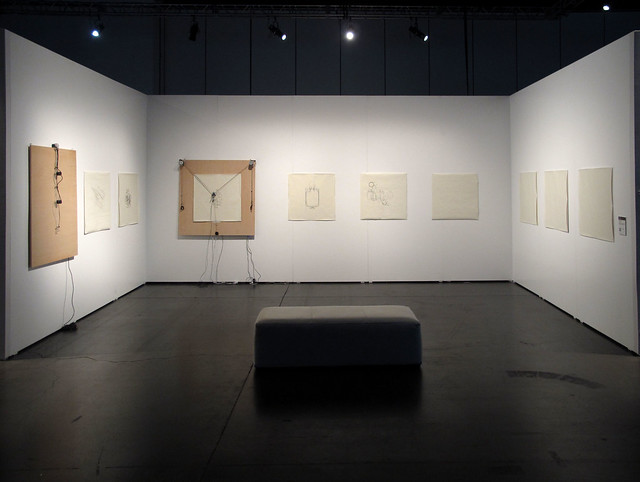SIGGRAPH 2013 Art Gallery. Anaheim, CA.

My description from the special issue of Leonardo:
Drawing Machine is the latest in a series of conceptual subtractions from the parameters of drawing as an art act. A precision-controlled CNC device labors in place of the artist, working with unfaltering patience and inhuman precision to fill a sketchbook with images over the course of the exhibition.
This project marries my technical interests in motor control, image vectorization, and machinic spectacle with my history as a painter. Drawing has been my most heartfelt and originally self-defining activity as an artist, but I find it difficult to place the value of drawing in the context of other readily available image-reproduction technologies. A doppelgänger or substitute, this project reintroduces drawing as the output of a laboring machine, raising questions of absence and presence, expression, and the value of the handmade.
The uneasy combination of technical fascination and artistic desire is a recurrent theme through- out my work. Other projects have reflected on computer vision, natural language processing, and speech recognition, colliding these techniques with personal content to illuminate essential questions of identity, embodiment, and cognition in our time.
Drawing Machine examines multiple notions of scale. As a mechatronic system, the twin-pulley hanging plotter system is designed to be inherently scalable. The drive belt and modular pulley system can expand the working space of the machine from 14 inches x 17 inches (the size of the sketchbook) to a 12 foot x 20 foot wall, and it can operate with the same sub-millimeter precision across those scales. Beyond these physical qualities, Drawing Machine examines the dynamics of plasticity and material resistance in digital fabrication processes: how the relative ease of transformations in software manifest as time-to-manufacture, duration, and cost when realized in the material world.
In the larger context of my art practice, I wish to achieve some reconciliation of my ambition to vanguard technical explorations with the tradition and history of a studio-based practice. This piece is one incremental excursion in that larger project.
from Leonardo Journal, Volume 46, Issue 4, 2013
previous drawing machine versions
[flatfile id=”72157634818493670″ limit=”9″]
The drawing machine plots images, reducing the practice of drawing to the gesture of tracing and inscription, without body, awareness, expressivity. It is the latest in a series of projects that have successively eliminated perception, expressivity, and now manual labor from drawing to see what remains. Perhaps just the act of inscription. Or the production of an empty art object. What is left to eliminate?
Does the drawing machine have an essential character? Yes, a machinic character. Like other Computer Numeric Control (CNC) devices, it automates production, operating with a patience, repeatability, and precision which a human could not achieve. Drawing a grid is it’s “bread and butter.”
Sol Lewitt’s wall drawings are the best comparison to the drawing machine, with implications for understandings of work and labor in creative practice. They separate the labor of the project of drawing from conceptualization of the piece. Invisible labor of untold gallery assistants manufacture patterns according to the rule systems he created. My drawing machine raises the question, what distinguishes machine labor from hired human labor?
The drawings are in chronological order.
[flatfile id=”72157627678471452″]
top